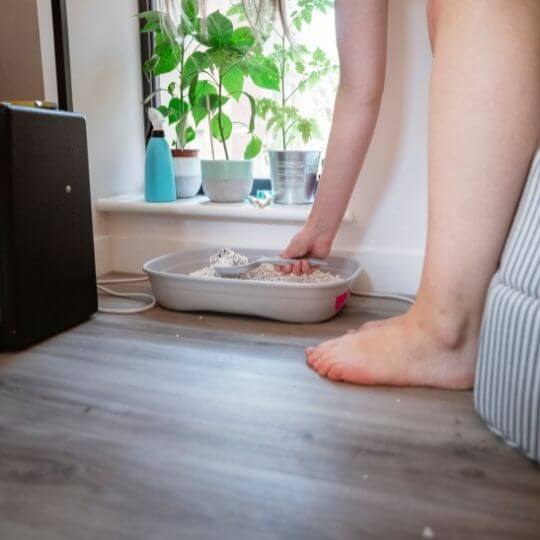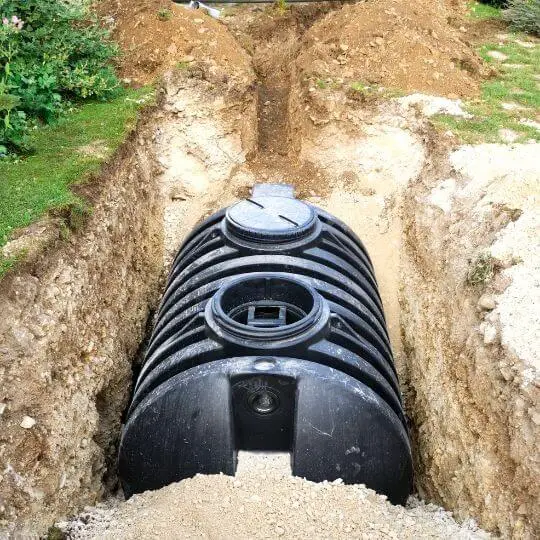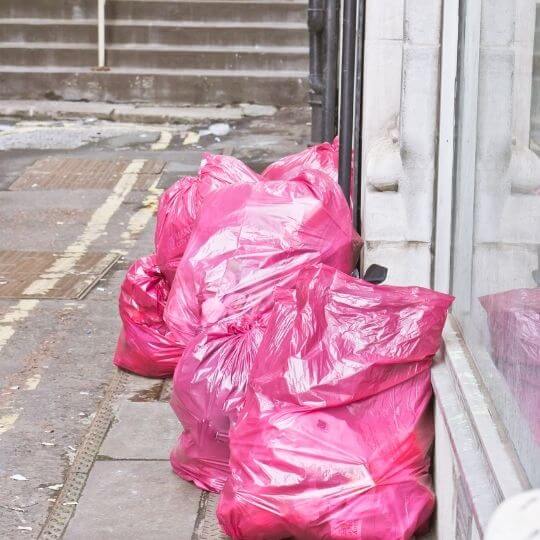When you own a cat, handling its litter box is an essential task. Cat owners don’t really love this part of having a pet because it’s messy and smelly. So, they are looking for ways to make this chore easier. This is why many people ask: can you flush cat litter?
This practice could spare you a travel to the dumpster carrying a tray of litter and cat droppings. So, is it a good idea to send it down the drain?
Keep on reading to find out whether flushing cat poop is OK or not!
What are the risks associated with flushing cat litter?

First of all, any plumber will tell you that you can only flush human waste and toilet paper. Any other item is NOT good to flush down the toilet, including tissues, wipes, and dental floss.
In order to find out – can you flush cat litter – let’s see what it contains.
Used cat litter contains cat litter and cat droppings or poop.
Let’s start with the litter.
Cat litter composition varies from one brand to another. This material intended to absorb cat droppings contains any the following:
- Clay and other minerals
- Natural ingredients like pine
- Synthetic crystallized silica
- Mineral oil to prevent the litter from generating dust and sticking to the bottom of the box
- Baking soda to neutralize odors
- Fragrances to reduce odor
Modern cat litter was invented in 1947 by Edward Lowe, who created a mixture of clay minerals. His container of “Fuller’s Earth” contained materials able to absorb their weight in liquid.
Nowadays, cat litter is an almost $10 billion industry in the United States and there are many types of litter to choose from.
Today’s cat litter contains highly-absorbent fibers such as bentonite. Whether it’s sodium bentonite or calcium bentonite, this material can swell up to 15 times its original volume. There also are clumping and non-clumping formulas you can choose from.
If you have read carefully so far, you have probably noticed that cat litter can absorb lots of cat waste. This means it will also absorb water.
Now, if cat litter reaches your drain pipes, that absorbent material will swell up with water and block your pipes. So, a simple look at cat litter shows you this is not something you should flush down the toilet.
But can you flush cat litter once it has been used?
Sorry to say this is not an option either.
Even if the litter is used, not all the absorbent fibers have done their job yet. Try to pour some water into your used litter box and you will see the litter continuing to swell. The same process will happen inside your drain pipe, leading to clogs.
To draw a partial conclusion, the first risk associated with flushing cat poop is clogging your drain.
But there’s more to it.
Have you ever heard something about pregnant women being advised against handling cat litter?
This is because of a parasite that can be found in cat poop, Toxoplasma gondii.
Let’s see why this parasite is such as big issue and what harm it can cause to humans.
What is Toxoplasma?
Toxoplasma gondii is a single-cell parasite that can persist for a long time in the bodies of animals and humans.
Healthy people with a strong immune system have very few or no symptoms. The parasite can be a problem for people with a compromised immune system.
People can get toxoplasmosis from multiple sources:
- Eating contaminated, undercooked meat;
- Accidentally ingesting the parasite after handling contaminated meat and not washing your hands;
- Eating food contaminated by utensils that have had contact with raw contaminated meat;
- Swallowing the parasite after contact with cat feces that contain Toxoplasma;
- Accidentally ingesting contaminated soil;
- Mother-to-child or congenital transmission;
- Receiving an infected organ transplant or via transfusion of infected blood – more rarely.
Two categories of people are at risk for developing severe toxoplasmosis:
- Infants born to mother recently infected with Toxoplasma gondii, during or just before pregnancy;
- Persons with severely weakened immune systems, such as individuals with AIDS and undergoing certain types of chemotherapy. People who have recently received an organ transplant are also at risk.
People who are at risk can keep their cats if they take safety precautions:
- Changing the cat litter box daily. The parasite becomes infectious after 1 to 5 days after being shed in a cat’s feces;
- Avoiding to change the cat litter or wearing disposable gloves and washing hands with water and soap afterwards;
- Keeping cats indoors so they do not become infected with Toxoplasma;
- Not handling or adopting stray cats;
- Not feeding raw or undercooked meats to your cat;
- Keeping outdoor litter boxes covered.
Is it illegal to flush cat poop?
Cats can spread Toxoplasma in their feces for 1 to 3 weeks following infection with the parasite. Most times, cats do not display symptoms and we don’t know whether they are infected or not.
If the cat’s feces contain the parasite and you flush them, you can contaminate wastewater with Toxoplasma.
Even if wastewater is treated, treatment facilities are not able to remove Toxoplasma from water. The contaminated water is discharged back into the environment and in waterways. The parasite can infect fish, shellfish, and other marine life forms. From there, the parasite can infect people who eat the contaminated food.
So far, there is no law that makes it illegal to flush cat litter or poop.
However, there are recommendations not to.
Can you flush cat poop in septic tank?

What if you are not connected to the municipal sewage system?
Can you flush cat poop in septic tank?
After all, it’s your septic tank, on your property.
Just cat poop will not damage your septic tank, but may contaminate the wastewater inside it. If you accidentally come into contact with the contents of your septic tank, you can ingest the parasite.
The biggest problem is when you flush cat litter and the material reaches your septic tank. If the cat litter contains bentonite, you will most likely damage your tank. Bentonite is a type of clay that hardens when it comes into contact with water.
So, if you were wondering – can you flush litter clumps – the answer is no. Clumps indicate the litter is the type that clumps and can cause serious blockages in your drain pipe.
How to handle cat litter properly?

Cats are not exactly the most environmentally friendly pets.
Domestic felines are known to kill millions of birds each year as they are left outdoors unsupervised.
The most common and cheapest brands of cat litter contain sodium bentonite. Mining for this material tears up land surface. Disposed litter adds millions of tons of material to landfills each year.
The best you can do is to use organic biodegradable litter made from natural materials. Place used litter in a biodegradable bag to give it a better chance of breaking down in the dump.
So Can You Flush Cat Litter?
Many pet owners confess: I flushed cat litter down the toilet. That’s not good. Especially when the litter contains absorbent fibers or clay, you risk serious damage or clogs in your drain pipes.
Our strong recommendation is to never flush litter or cat poop.
If you have flushed litter, best is to have a plumber inspecting your drain system for clogs.
Cat litter belongs to the bin, securely tied in a bag so it does not contaminate the environment.

Michael Davis is a heating & plumbing expert who currently works as independent contractor in SC. He also writes for Plumbertip.
For almost 10 years he worked on various plumbing tasks across South Carolina.


